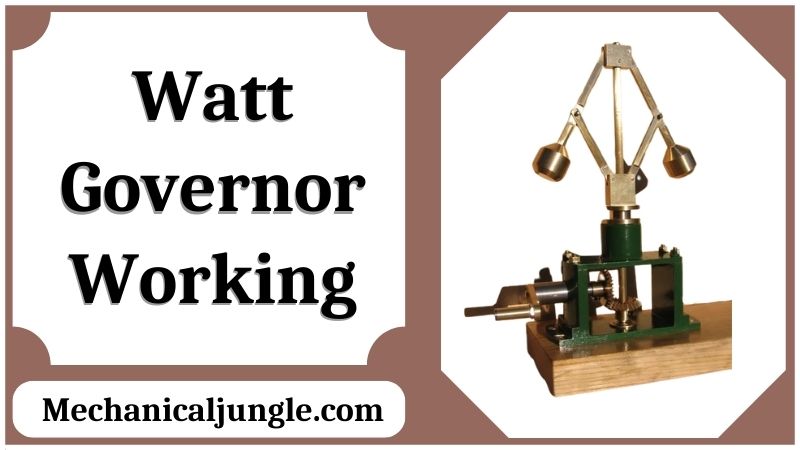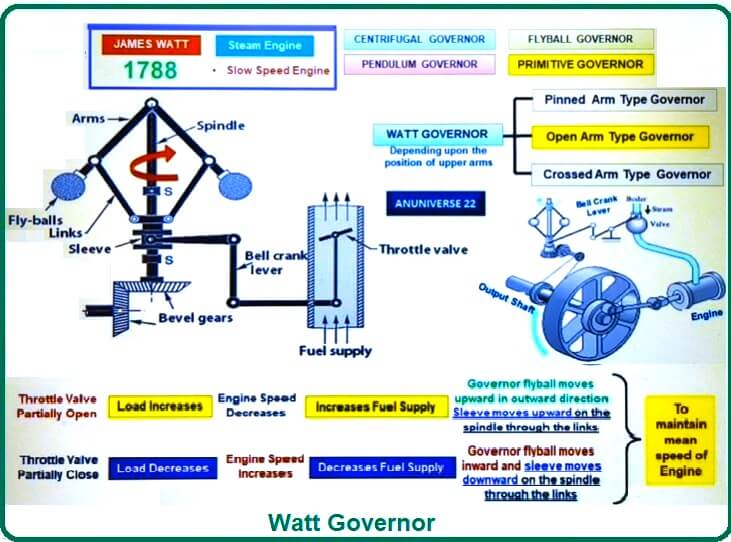
What Is Watt Governor?
The simplest types of the centrifugal governor are the watt governor. In the previous article, we discussed the centrifugal governor in detail. In this article, we are goings to discuss the Governor of Watt in more detail.
Watt Governor:

Watt governors are the simplest form of centrifugal governors. Centrifugal governors are a special type of governors with a reaction system that controls engine speed by controlling the flow of fuel or working fluid.
The Watt Governor has two fly balls attached to two arms of negligible mass. The watt governor is used to supply the required amount of fuel at a different speed.
When the engine speed increases, the fuel supply needs to increase, and as the engine speed decreases, the fuel supply should decrease.
So the fuel supplies should be regulated according to the engine speed. With the help of the watt governor, we can achieve the required load on the engine with continuous smooth function.
Construction of Watt Governor:
A watt governor is a simple form of centrifugal governor used to control the fluctuations developed at the time the engine is run. Governor, The type of governor, is used to supply the required amount of fuel at various speeds, the main reason being to control it. Engine speed according to conditions.
When we need to increase the fuel supply to increase the speed, and if a lower speed is required, the fuel supply must be reduced. Controlling the fuel supply is done with the help of a watt governor; hereby, we Can achieve the required load on the engine with continuous smooth function.
In this process, the main function is carried out by the moments of the sleeve, which moves upward & downward with the help of rotating balls; the sleeve gets lifted when the two balls attached to the arms rotate, & the momentum of the sleeve depends on what speed the balls rotate. According to the sleeves lifted, the supply of fuel to the engine depends.
Working of Watt Governor:
Watt governor has two balls that are attached to both arms, which are of negligible mass. The upper part of the arms is taped so that its balls move up and down. These arms are attached to the axles. The engine drives the axle through the bevel gear.
When the engine speed increases, the spindle rotates at high speed. The arms, as well as the balls attached to the spindle, rotate at high speeds. The balls move in an upward direction as they spin off the ball at high speed, and the upper part of the arms are tapped on the axis.
The lower arms are attached to the sleeves. These sleeves are placed on the spindle in such a way that it rotates with the spindle and can slide up & down according to the spindle’s rotation speed.
As the engine speed increases and the ball moves in an upward direction, the sleeve attached to the arms also moves upward and similarly downwards as the engine speed decreases. There are stoppers at the top and bottom of the sleeve to limit motion above and below the sleeve.
Now, there are two cases: –
- When the engine speed increases.
- When the engine speed decreases.
#1. When the Engine Speed Increases
When the engine speed increases, the load on the engine decreases, and the rotation speed of the spindle increases. The centrifugal force on the balls increases and the balls move upward; and therefore, the sleeve moves upward as the sleeve moves upward.
The upward movement of the sleeve causes the throttle valve at the end of the bell crank lever to decrease fuel supply. Power output is reduced.
#2. When the Engine Speed Decreases
When the engine speeds decrease, the load on the engine increases, and the rotation speed of the spindle decreases. The centrifugal force on the balls decreases, and the balls move downward.
As the balls move downward, the sleeves move downward, thereby increasing the fuel supply to the throttle valve and increasing the output of electricity.
Watt Governor Height Equations & Calculations (Design):
m = Mass of the ball, kg
w = Weight of ball, N
h = Height of the governor-verticals distances between the center of the ball and a point O, where the arms meet the axis of the spindle, m
r = Radial distances of balls from the axis of the spindle, m
ω = Angular velocity of the balls & arms about the spindles axis, rad/s
T = Tension in the arm, N
It is assumed that the sleeves are frictionless, Weight of links/ arms is negligible. Now the balls are in equilibrium under the action of the following forces.
- Centrifugal force acting on balls, Fc = m ω2 r
- The Weight of balls, w = mg
- Tension in the upper arms, T
There is no tension in the lower arms because it is assumed the sleeve is frictionless and the Weight of the arms is negligible.

OR
Take a moment of these forces about O.
For equilibrium

Sleeve lift equal to 2 (h2 – h1)
h1 sleeve position at speed N1
h2 sleeve position at speed N2
- The height of the ball is independent of the mass of the ball; it only depends on the speed of the spindle.
- At higher speed, the sensitivity of the watt governor will decrease.
Limitations of Watt Governor:
- Watt governors are limited to vertical position applications.
- Watt governor is used in very slow-speed engines. At higher speeds, the sensitivity will decrease.
Applications of Watt Governor:
- It is used in ships and trains to maintain the speed of the engine.
- It can be used in AC generators to maintain an electric supply.
Frequently asked questions (FAQs) that could be included in your article about the Watt Governor:
What is a Watt Governor?
A Watt Governor is a type of centrifugal governor designed to regulate the speed of engines by controlling the flow of fuel or working fluid based on changes in engine speed.
How does a Watt Governor work?
It works by using centrifugal force generated by rotating balls to adjust the position of sleeves, which in turn regulates the throttle valve controlling fuel supply. When engine speed increases, the governor reduces fuel supply, and vice versa.
What are the components of a Watt Governor?
A Watt Governor typically consists of two fly balls attached to arms of negligible mass, connected to a spindle driven by the engine. The movement of these balls and arms controls the position of sleeves that adjust fuel supply.
What are the main applications of Watt Governors?
Watt Governors are commonly used in applications such as ships, trains, and AC generators to maintain engine or generator speed, ensuring consistent and efficient operation.
What are the limitations of Watt Governors?
They are primarily suitable for vertical applications and are less effective at very high speeds due to reduced sensitivity.
How is the sensitivity of a Watt Governor affected by speed?
At higher speeds, the sensitivity of a Watt Governor decreases, which can limit its effectiveness in applications requiring precise speed control.
What are the design considerations for a Watt Governor?
Design considerations include the mass of the balls, the dimensions of the arms and sleeves, and ensuring frictionless movement of the sleeves for accurate speed regulation.
How does a Watt Governor contribute to engine efficiency?
By maintaining a consistent engine speed, a Watt Governor helps optimize fuel consumption and power output, thereby improving overall engine efficiency.

